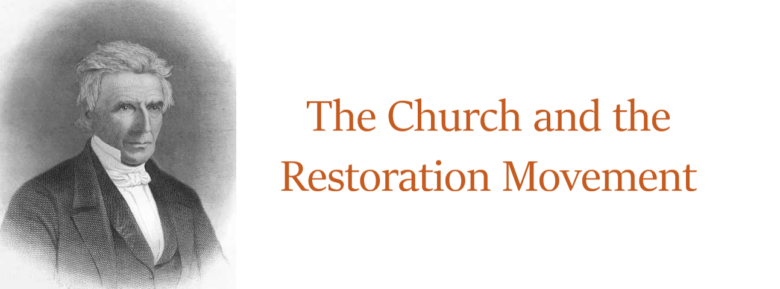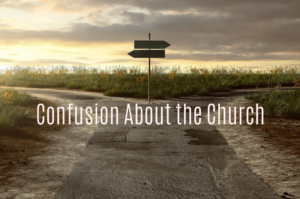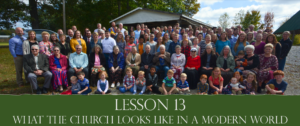The last several lessons in this series covered the Protestant Reformation, a very influential religious movement that spanned roughly 100 years (1500-1600’s). To brush up on this important piece of church history, read or watch the following lessons- Lesson 8, Lesson 9, Lesson 10. While the Reformation Movement was remarkable, it failed in regaining what was lost in the Catholic Church. Where men like Martin Luther, John Calvin, Ulrich Zwingli, and others fell short in going all the way back to the Bible for church doctrine and practice, there would be men who came along in the early 1800’s to complete this mission. This effort became dubbed the Restoration Movement and took place in early America.
An Explosion of Churches
One product of the Reformation Movement overlooked in the last three lessons was the resulting explosion of denominations in opposition to the Catholic Church. See this brief list of denominations and their origins from this time period.
- Mennonite Church-Zurich, Switzerland, est. 1525
- Lutheran Church-Augsburg, Germany, est. 1530 by Martin Luther
- Church of England-England, est. 1535 by King Henry VIII
- Presbyterian Church-Switzerland, est. 1535 by John Calvin
- Dutch Reformed Church-Holland, est. 1560
- Baptist Church-London, England, est. 1607 by John Smyth
- American Baptist-Providence, R. I., est. 1639 by Roger Williams
- Quakers-England, est. 1650 by George Fox
- Brethren (Dunkards)-Schwarzenau, Germ., est. 1708 by Hochmann & Mack
- Methodist Church-London, England, est. 1729 by John Wesley
All of these churches were established on two basic principles, 1) they opposed the Catholic Church and 2) the church founder disagreed on some teaching or practice with all the other churches being created. The number of churches would grow exponentially more in the late 1800’s, but between this and that lies the Restoration Movement in America.
The Beginnings of Restoration
The essence of the Restoration Movement is in the name. Men were diligent in studying their Bibles at this time as the Bible was now in the hands of the general populace. Deep thinkers from humble beginnings, raised in the denominations listed above, started comparing what they read in the Bible with what they saw being practiced in the churches. Like the reformers 150 years before, they saw a disparity between the two and began the process of change. One example of such change is found in the Methodist Church circa 1794. In Surry County, Virginia members of the Republican Methodist Church gathered together to discuss matters of faith and practice. This group had recently broken off from the Methodist Episcopal Church over matters of unscriptural church government. The conclusions of this meeting were as follows-
- The Lord Jesus Christ is the only Head of the Church (as opposed to a pope or other bishop).
- The name for members of Christ’s church is “Christian,” excluding all party and sectarian names (i.e. Methodist, Presbyterian, Baptist, etc.)
- The Holy Bible, or the Scriptures of the Old and New Testaments, is the only creed, and a sufficient rule of faith and practice (as opposed to church creeds such as the Augsburg Confession of Faith).
- Christian character is the only test of church fellowship and membership.
- The right of private judgment, and the liberty of conscience is the privilege and duty of all (as opposed to a general church council)
Whether right or wrong in their conclusions of faith and practice, the conclusions of this meeting illustrate the spirit of the Restoration Movement. It was a religious movement that ushered restoring the church to its 1st century beginnings. With the Bible as the only rule, the church could be restored to how Christ originally intended.
Stone & Campbell
![[Tags] last-will-and-testament-225x300 Lesson 11- The Church & the Restoration Movement Pt. 1](https://fiveminutebiblestudy.com/wp-content/uploads/2019/09/last-will-and-testament-225x300.jpg)
Three individuals were especially instrumental in this movement- Barton W. Stone, Alexander Campbell, and Walter Scott. Each of these men were from different regions of the United States, but all three shared the same rule for interpreting scripture. Barton W. Stone was a member of the Presbyterian Church originally. He and a few other fellows departed from this denominational network of churches, recognizing the practice of general church councils and man-made creeds of faith to be foreign to scripture. They started meeting under the name of the Springfield Presbytery, but after much deliberation they finally concluded to abandon this name and drew up what they called The Last Will and Testament of the Springfield Presbytery. Within this document were two statements of faith that reflect very well the spirit of restorationism.
- We will, that our power of making laws for the government of the church, and executing them by delegated authority, forever cease; that the people may have free course to the Bible, and adopt the law of the Spirit of life in Christ Jesus.
- We will, that the people henceforth take the Bible as the only sure guide to heaven.
The spirit of this Last Will and Testament was essentially: the Bible is our authority and the Bible alone. Alexander Campbell’s father -Thomas Campbell- shortly after the Last Will and Testament was published, made a similar statement about determining faith and practice. Thomas Campbell said,
“Where the Scriptures speak, we speak; and where the Scriptures are silent, we are silent.”
Alexander Campbell would pick up where his father left off and become perhaps the most influential man within this movement of Christians seeking to restore New Testament Christianity in all its simplicity. Stone and Campbell would be so influential, in fact, that many today call this movement the Stone-Campbell Movement.
Pt. 2 Coming Soon
This lesson introduced what the Restoration Movement was essentially about. Part 2 will identify more specifically what these men found to be New Testament Christianity upon studying the Scriptures. What teaching and practices did they abandon? Stay on the lookout for Lesson 12!
Resources- 1) Attitudes and Consequences by Homer Hailey 2) The Hazard of the Die by James Wilburn


